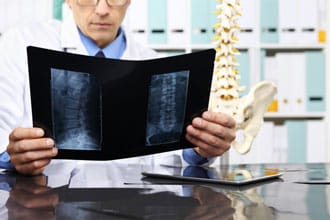Representing Workers Facing Back And Spinal Cord Injuries
There are an estimated 17,000 spinal cord injuries every year in the United States. Almost 35 percent, or more than 4,000 of these injuries, are due to work-related accidents, falls or sporting accidents. More than 80 percent of spinal cord injury patients are men, in part because many of the injuries are sustained by construction workers on the job.
The high medical costs, loss of wages, loss of mobility, and the long road to recovery are all issues that need to be addressed, but missing one detail of the staggering amount of information can have dire consequences. Our dedicated staff is dedicated to your case, allowing you to focus on your recovery, your family, and your future. Our staff understands the workers’ compensation laws as well as the complex medical terms and we seek to get you the justice you deserve.
Spinal Cord And Back Injury Information
Spinal cord injury is damage to the thick bundle of nerves, or spinal cord, that runs from the brain all the way down to your lower back. The spinal cord carries sensations and nerve impulses to and from the brain to the rest of the body. This means that a spinal cord injury can affect sensation and control of movement of the whole body.
A serious injury can mean a loss of function such as mobility or feeling. The area along the spinal cord where an injury was sustained determines the degree of injury and loss of function. In general, the higher in the spinal column the injury occurs, the more dysfunction a person will experience.
A person can break bones in their back or neck yet not sustain a spinal cord injury. If the bones or vertebrae around the spinal cord are damaged, but the spinal cord is not affected, the individual may not experience paralysis once the bones are stabilized. Even so, broken bones in the back, as well as other back injuries, can be debilitating, and result in severely impaired movement and ongoing pain.
The most common causes of back and spinal cord injuries are falls from high places at construction sites, automobile or motorcycle accidents, dives into shallow water, or from sports such as hockey, football, water skiing and surfing.
The spinal cord may be injured if you have an injury to the back that:
- Breaks or dislocates the bones around the spinal cord;
- Penetrates through or between the bones (such as a bullet);
- Crushes the disks between the bones, pushing them into the spinal canal.
When the spinal cord is crushed, stretched or torn, and the nerves are damaged through bruising or swelling, the nerves may be able to heal. However, if the nerves are crushed, cut or torn, they may not be able to grow back, resulting in permanent paralysis to the legs or arms.
Recovery And Treatment
Currently, there is no known medical treatment to fully reverse damage to the spinal cord, although advances in recent years have improved the recovery from spinal cord injuries and significantly reduced the amount of time survivors must spend in a hospital. Researchers are continually working on new, innovative treatments that may promote nerve cell regeneration or increase the function of the remaining nerves.
There are three critical phases for back and spinal cord injury treatment – emergency or immediate treatment, early stages, and ongoing treatment.
Emergency treatment focuses on preventing any further injury and minimizing the long-term effects of any head or neck trauma. During the time immediately after an injury the medical team will focus on maintaining your blood pressure, breathing, head and neck stabilization, and avoiding possible respiratory or cardiovascular complications. The patient will be sedated to prevent movement that could result in more damage.
Early treatment for spinal cord injuries typically involves a combination of the following:
- Medication: The doctors will more than likely use a corticosteroid. This medicine has been known to cause some recovery in people with a spinal cord injury if given within eight hours of injury. The treatment reduces damage to nerve cells and can decrease inflammation near the site of injury.
- Immobilization: Traction may be employed to stabilize the spine and to bring the spine into proper alignment during healing. Traction may involve the use of metal braces attached to weights or a body harness and into your skull to hold it in place. In some cases, a rigid neck collar also may work.
- Surgery: Emergency surgery may be necessary to remove fragments of bones or foreign objects that appear to be compressing the spine. Surgery may also be needed to stabilize the spine to prevent future pain or deformity.
Ongoing treatment begins after stabilization and focuses on range-of-motion exercises, regaining muscle strength and skin conditioning. Medications are also a large part of the treatment for ongoing stabilization.
Computerized Devices
Computer-driven wheelchairs, electrical stimulation devices, and neural prostheses are all being offered, and continue to undergo improvements, to enhance the mobility and self-sufficiency of spinal cord patients.
Many people are not in a financial position to afford the essential needs such as computerized mobility devices, accessible housing, wheelchair-equipped vehicles, and personal assistance services. They may be able to get assistance from their health and disability insurance companies and from the state or federal government as well.
Learn More About Your Options
The Maguire Law Firm understands the overwhelming physical and mental pain and suffering that results when you or someone you know has sustained a serious back or spinal cord injury while on-the-job. For help with your claim in the Myrtle Beach, South Carolina area, call 843-491-5044. You can also contact us online. We offer flexible appointment scheduling for your convenience.

